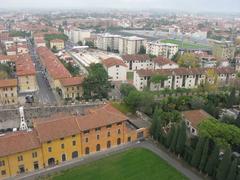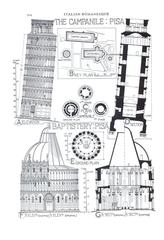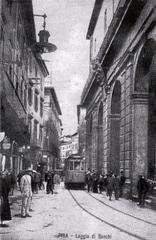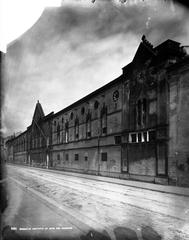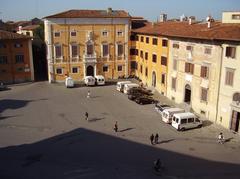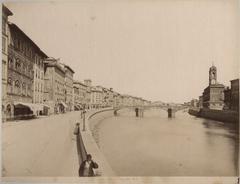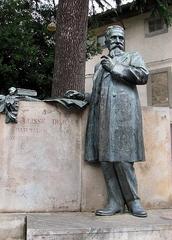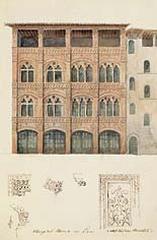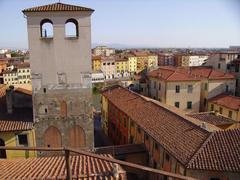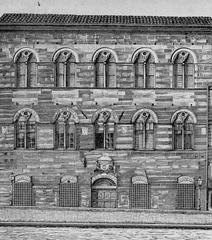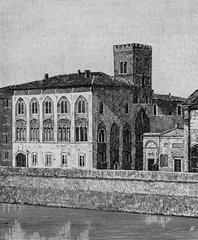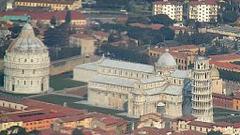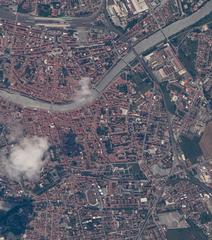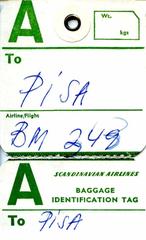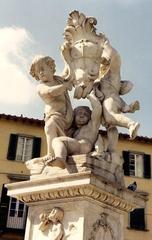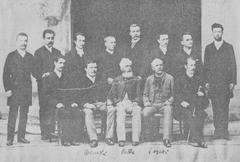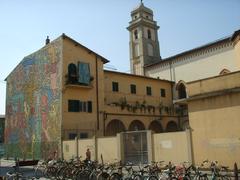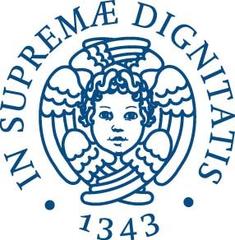Visiting Niccola Pisano’s Pulpit at the Pisa Baptistery: Tickets, Hours, and Expert Tips
Date: 14/06/2025
Introduction
Standing proudly in Pisa’s Piazza dei Miracoli, Nicola Pisano’s pulpit inside the Baptistery of St. John is a masterwork that marks the dawn of Italian sculptural classicism and the transition between Romanesque and Gothic artistry. Crafted in 1260, this pulpit is celebrated not only for its technical brilliance and emotional depth but also for its pivotal role in shaping the course of European art and laying a foundation for the Renaissance. As part of Pisa’s UNESCO World Heritage ensemble—alongside the Leaning Tower, Cathedral, and Camposanto—the pulpit draws art lovers, historians, and travelers from around the world (italianrenaissance.org; Go Ask a Local).
This detailed guide will provide a rich exploration of Pisano’s life, the artistic and theological significance of the pulpit, and essential practical information for visiting, including hours, ticketing, accessibility, and nearby attractions. Whether you are an art enthusiast, a student of history, or a curious traveler, use this resource to enhance your experience of one of Italy’s greatest cultural treasures (britannica.com; finestresullarte.info).
Table of Contents
- Nicola Pisano: Life and Artistic Development
- Origins and Historical Context
- The Pulpit: Artistic Features and Symbolism
- Practical Visitor Information
- Nearby Attractions and Cultural Context
- FAQ: Essential Visitor Questions
- Conclusion and Recommendations
- References and Further Reading
Nicola Pisano: Life and Artistic Development
Nicola Pisano (c. 1220–1284) is often hailed as the founder of Italian sculptural classicism. Likely trained in southern Italy, Pisano was deeply influenced by ancient Roman sarcophagi, which inspired his naturalistic figures and classical motifs. His arrival in Pisa, a flourishing maritime republic, coincided with a period of artistic and civic ambition, making it the ideal location for his innovative work (Go Ask a Local; The Geographical Cure).
Pisano’s pulpit for the Pisa Baptistery (1260) is widely regarded as the turning point in Italian sculpture, creating a bridge between Romanesque solidity and Gothic expressiveness. His approach influenced contemporaries and later masters—his son Giovanni Pisano, Donatello, and even Michelangelo—cementing his place in art history (britannica.com).
Origins and Historical Context
The Pisa Baptistery, begun in 1153 and completed in the 14th century, is the largest baptistery in Italy. Its construction reflects the city’s medieval prosperity and its desire to rival other Tuscan centers. Pisano’s commission for the pulpit was both a reflection of his rising status and Pisa’s ambition to showcase religious and artistic innovation (finestresullarte.info).
The Pulpit: Artistic Features and Symbolism
Structural Innovations and Design
Pisano’s pulpit stands on a hexagonal base, harmonizing with the Baptistery’s circular plan—a radical departure from previous rectangular or square pulpits. It is supported by seven columns: six perimeter columns (three resting on stylized lions) and one central column adorned with three telamons (male figures), symbolizing theological and architectural strength (it.wikipedia.org).
Sculptural Program and Iconography
The parapet is decorated with five high-relief marble panels, each depicting a central event in the life of Christ:
- The Nativity
- The Adoration of the Magi
- The Presentation in the Temple
- The Crucifixion
- The Last Judgment
Pisano’s figures are rendered with unprecedented naturalism and movement, inspired by classical antiquity. Notable details include the Madonna in “Adoration of the Magi,” modeled after Roman sarcophagi, and the statue of Fortitude—a rare post-antique nude referencing Hercules (italianrenaissance.org; britannica.com).
The pulpit also features Gothic elements: trilobed arches, spandrels with prophets and evangelists, and statues of cardinal virtues, St. John the Baptist, and the Archangel Michael, blending stylistic traditions (it.wikipedia.org).
Symbolic and Theological Program
The pulpit’s imagery is deeply symbolic:
- Lions (base): Represent the foundational strength of faith.
- Seven columns: Symbolize the seven sacraments.
- Prophets and evangelists: The spiritual pillars of the church.
- Relief panels: The revelation of Christ and the fulfillment of salvation history.
The narrative focus on Christ’s infancy and Passion reflects contemporary Franciscan spirituality and the influence of Pisa’s theological thinkers (it.wikipedia.org).
Artistic Techniques and Workshop Practice
Pisano revolutionized relief sculpture by deeply undercutting figures to create dramatic shadows and spatial depth. The emotional intensity and varied poses of his figures were innovative for the time and hint at workshop collaboration, particularly with his son Giovanni Pisano and Arnolfo di Cambio (britannica.com).
The eagle lectern, symbolizing St. John the Evangelist, and the use of red marble and colonnettes for framing further showcase Pisano’s attention to symbolic meaning and visual harmony (italianrenaissance.org).
Practical Visitor Information
Location and Getting There
- Address: Baptistery of St. John (Battistero di San Giovanni), Piazza dei Miracoli, Pisa
- By Foot: 15–20 minutes from Pisa Centrale train station
- By Public Transport: City buses connect the station and other parts of Pisa to the Piazza (Tourist Secrets)
- By Car: Parking available at Via Pietrasantina, a 10-minute walk from the Baptistery (Gites en Toscane)
Visiting Hours
- General Hours: 9:00 AM – 7:00 PM daily (April–September, sometimes until 8:00 or 10:00 PM)
- Last Entry: 30 minutes before closing
- Seasonal Variations: Check the Opera della Primaziale Pisana website for current info (European Traveler)
Tickets and Guided Tours
- Tickets: Not sold at the Baptistery entrance; purchase at Sinopie Museum, Palazzo dell’Opera del Duomo, or online (Opapisa)
- Baptistery Only: €5 adults, €2 children (6–18), under 6 free
- Combination tickets: €10 for multiple monuments; Leaning Tower entry: €20 (includes Cathedral)
- Advance booking recommended (Visit Italy)
- Guided Tours: Available in multiple languages; often include Baptistery, Cathedral, Leaning Tower (Visit Italy)
Accessibility
- The Baptistery and Piazza are wheelchair accessible, with ramps and accommodations for visitors with limited mobility (Opapisa).
- Restrooms are available in the Piazza dei Miracoli area.
Photography and Visitor Tips
- Photography: Non-flash photography is permitted; tripods may be restricted.
- Dress Code: Modest attire is required.
- Facilities: No air conditioning; dress appropriately in summer. No large bags/luggage allowed.
- Acoustics: Staff demonstrate the Baptistery’s famed echo effect twice an hour—ask on arrival (European Traveler).
- Suggested Visit Duration: 30–60 minutes for the Baptistery; half a day for all Piazza sites.
Nearby Attractions and Cultural Context
- Cathedral of Santa Maria Assunta
- Leaning Tower of Pisa
- Camposanto Monumentale
- Museo dell’Opera del Duomo
- Museo delle Sinopie
- Palazzo Blu (Visit Tuscany)
Wander through medieval streets like Borgo Stretto and sample local cuisine in trattorias along the Arno (bitesizetourist.com). Explore museums and churches to deepen your understanding of Pisa’s rich heritage (wideworldtrips.com).
FAQ: Essential Visitor Questions
Q: Can I buy Baptistery tickets at the entrance?
A: No, tickets must be purchased in advance online or at designated offices.
Q: Is the Baptistery wheelchair accessible?
A: Yes, ramps and accommodations are provided.
Q: Are guided tours available?
A: Yes, in several languages, often covering all Piazza dei Miracoli monuments.
Q: What are the best times to visit?
A: Early morning or late afternoon, especially in spring or autumn, to avoid crowds.
Q: Is photography allowed inside the Baptistery?
A: Generally yes, but flash and tripods are not permitted.
Conclusion and Recommendations
Nicola Pisano’s pulpit is a landmark of European art and a highlight of any visit to Pisa. Its innovative blend of classical and Gothic elements, theological symbolism, and technical virtuosity make it an essential stop for understanding the roots of the Renaissance. By planning ahead—booking tickets, checking hours, and considering a guided tour—you’ll ensure a smooth and enriching visit. Don’t miss exploring the broader Piazza dei Miracoli and Pisa’s vibrant city life to complete your cultural journey.
For updates, bookings, and expert insights, download the Audiala app and follow our social media channels. Explore our other detailed guides to make your Italian adventure unforgettable!
References and Further Reading
- Discover the Monument Niccola Pisano in Pisa: Hours, Tickets, and Historical Insights, 2024, Go Ask a Local (goaskalocal.com)
- Exploring the Pulpit of the Pisa Baptistery: History, Art, and Visitor Information, 2024, Italian Renaissance (italianrenaissance.org)
- Pulpit of the Pisa Baptistery Visiting Hours, Tickets, and Visitor Guide, 2024, European Traveler (european-traveler.com)
- Visiting Nicola Pisano’s Pulpit in Pisa: Hours, Tickets, and Cultural Insights at Piazza dei Miracoli, 2024, Finestre sull’Arte (finestresullarte.info)
- Nicola Pisano Biography and Artistic Influence, 2024, Britannica (britannica.com)
- Pisa Baptistery Information, 2024, Visit Tuscany (visittuscany.com)
- Pisa Baptistery Tickets and Tips, 2024, Visit Italy (visititaly.eu)
